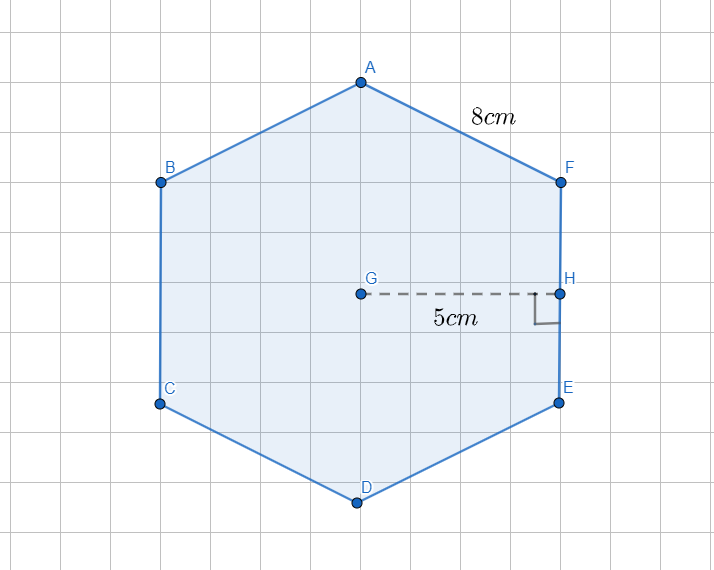
What is the area of this regular hexagon?


Answer
507.3k+ views
Hint: The question that we are given consists of a regular hexagon with sides which are $8$ cm in length and has an apothem of $5$ cm of length. We will find the area of the given hexagon using the apothem method where we will have to use the given length of the apothem and the perimeter of the hexagon. For that we will first find the total perimeter of the hexagon i.e., the sum of all the sides of the hexagon and then we use the formula, $Area=\dfrac{1}{2}\times perimeter\times apothem$ . Incorporating all the values in the formula we get the area of the hexagon given.
Complete step-by-step answer:
The hexagon that we are given has the sides of length $8$ cm and has apothem of length $5$ cm.
An apothem (sometimes mentioned as apo) of a regular polygon (which is a hexagon in this case) is basically a line segment from the centre to the midpoint of one of its sides. We can also say that it is the line drawn from the centre of the polygon that is perpendicular to one of its sides. The length of that line segments refers to the apothem of the polygon.
To find the area of this hexagon we will use the apothem method where we can find the area of the hexagon just using a simple formula consisting of the perimeter of the hexagon and its apothem.
Apothem of the hexagon, $a=5$ cm
Perimeter, $p=n\cdot 8$ cm
For hexagon, $n=6$
Hence, Perimeter, $p=6\cdot 8=48$ cm
According to the apothem method, $Area=\dfrac{1}{2}\times perimeter\times apothem$
Or, $Area=\dfrac{1}{2}\times p\times a$
$\Rightarrow Area=\dfrac{1}{2}\times 48\times 5 cm^2$
$Area=120 cm^2$
Therefore, the area of the given hexagon is $120 cm^2$.
Note: For this problem we have chosen the apothem method to determine the area of the hexagon as the length of apothem was already given in the problem. If, the apothem was unknown we could have also used the formula which includes only the length of the sides of the hexagon as $Area=\dfrac{3\sqrt{3}{{s}^{2}}}{2}$ , where $s$ is the side of the hexagon.
Complete step-by-step answer:
The hexagon that we are given has the sides of length $8$ cm and has apothem of length $5$ cm.
An apothem (sometimes mentioned as apo) of a regular polygon (which is a hexagon in this case) is basically a line segment from the centre to the midpoint of one of its sides. We can also say that it is the line drawn from the centre of the polygon that is perpendicular to one of its sides. The length of that line segments refers to the apothem of the polygon.
To find the area of this hexagon we will use the apothem method where we can find the area of the hexagon just using a simple formula consisting of the perimeter of the hexagon and its apothem.
Apothem of the hexagon, $a=5$ cm
Perimeter, $p=n\cdot 8$ cm
For hexagon, $n=6$
Hence, Perimeter, $p=6\cdot 8=48$ cm
According to the apothem method, $Area=\dfrac{1}{2}\times perimeter\times apothem$
Or, $Area=\dfrac{1}{2}\times p\times a$
$\Rightarrow Area=\dfrac{1}{2}\times 48\times 5 cm^2$
$Area=120 cm^2$
Therefore, the area of the given hexagon is $120 cm^2$.
Note: For this problem we have chosen the apothem method to determine the area of the hexagon as the length of apothem was already given in the problem. If, the apothem was unknown we could have also used the formula which includes only the length of the sides of the hexagon as $Area=\dfrac{3\sqrt{3}{{s}^{2}}}{2}$ , where $s$ is the side of the hexagon.
Recently Updated Pages
Two men on either side of the cliff 90m height observe class 10 maths CBSE

What happens to glucose which enters nephron along class 10 biology CBSE

Cutting of the Chinese melon means A The business and class 10 social science CBSE

Write a dialogue with at least ten utterances between class 10 english CBSE

Show an aquatic food chain using the following organisms class 10 biology CBSE

A circle is inscribed in an equilateral triangle and class 10 maths CBSE

Trending doubts
Why is there a time difference of about 5 hours between class 10 social science CBSE

Write a letter to the principal requesting him to grant class 10 english CBSE

What is the median of the first 10 natural numbers class 10 maths CBSE

The Equation xxx + 2 is Satisfied when x is Equal to Class 10 Maths

Which of the following does not have a fundamental class 10 physics CBSE

State and prove converse of BPT Basic Proportionality class 10 maths CBSE




